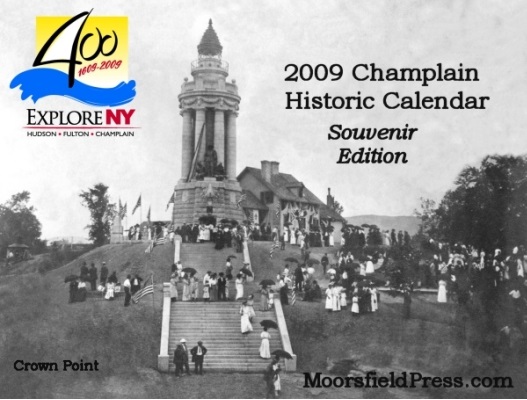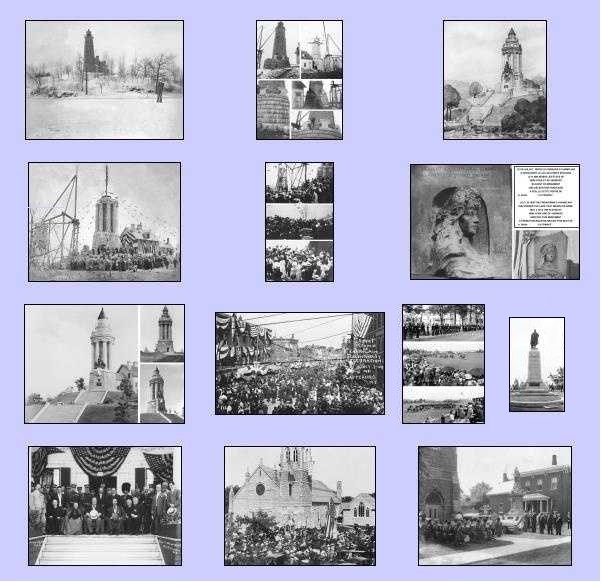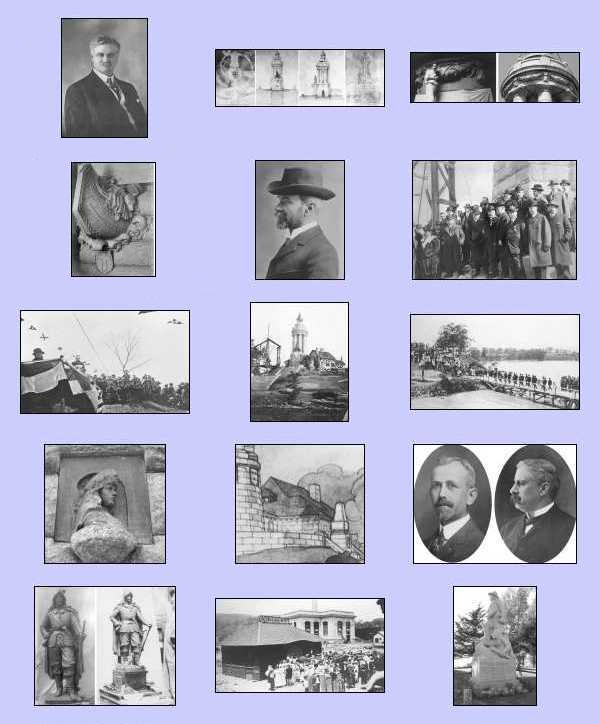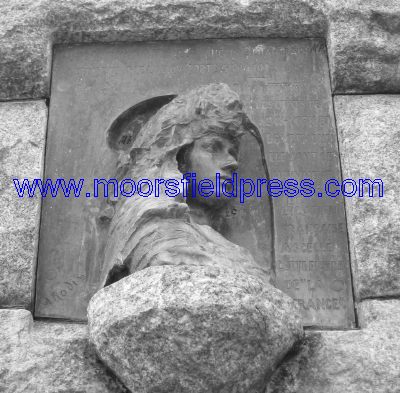
To purchase a calendar 2010 Calendar 2008 Calendar 2007 Calendar 2006 Calendar 2005 Calendar 2004 Calendar 2003 Calendar History of the Moorsfield Press (1919 to the 1980s) Clinton County Historical Association (CCHA) Crown Point State Historic Site (location of the Crown Point Memorial) Kent-Delord House Museum (adjacent to the Plattsburgh Memorial) |
|
 |
|
2009 Champlain Quadricentennial Calendar The 400th Anniversary of Samuel de Champlain’s Exploration of Lake Champlain 1609-2009 Champlain Memorial Lighthouse at Crown Point and
Plattsburgh Crown Point and the Story of the Rodin Bust “La France” ______________________________ |
|
Main month photographs. Each month's photograph is about 9-10 inches wide and has a detailed description. |
 |
Photographs used in the 15 page Historical Essay. The 2009 calendar also includes approximately 30 additional inset photos that are shown on the main calendar pages (not shown here). The inset images supplement the main month photographs. The calendar contains over 90 photos related to the 1909 and 1912 celebrations. |
 |
| Introduction written for the 2009 Historic Essay. |
This 2009
calendar contains a 15 page historical essay in the back
of the calendar and detailed monthly descriptions for 13
large format images and key dates related to the building
of the memorials. This is more than just a
calendar. In fact, the director of the Crown
Point Historic Site calls it a "big, new and
heavily-illustrated booklet (containing a tiny 2009
calendar) on the Champlain monuments at Crown Point and
Plattsburgh." A snippet of what is
written in the historical essay. There is
considerably more written for each section.
The Lake Champlain region had two celebrations related to the Tercentenary Celebrations of 1909. In July of 1909, the first Tercentenary celebration was held to commemorate the exploration of Lake Champlain by Samuel de Champlain three hundred years earlier. Celebrations on both sides of the lake included events at Crown Point, Plattsburgh and many other towns in the area over a one week period. During the 1909 celebrations, no Champlain memorials existed on the shores of Lake Champlain. The only statue of Champlain in the United States was at St. Mary’s Church in Champlain, New York, and this was dedicated on July 4, 1907. The New York and Vermont Tercentenary commissions resolved to build a memorial to Champlain as early as 1907 but several years of planning still needed to be done. It was not until 1910 and 1911, respectively, that the Champlain monument sites at Crown Point and Plattsburgh were selected and money appropriated. It took another year to build the monuments and they were dedicated in 1912 on July 5 and 6, respectively. This historic essay will focus on the design and building of the Crown Point and Plattsburgh Champlain Memorials. Much of what is written in the Tercentenary Final Reports of 1909 and 1913 is a literal transcription of the programs and speeches that occurred. In this essay, a behind-the-scenes look will explain the reasoning behind the selection of the two sites and other aspects of the monuments including the work by French Ambassador Jean Jusserand concerning the Rodin bust “La France”.
Although
this calendar and historic essay is written for the
Quadricentennial (400th anniversary) celebrations of
2009 and shows photographs from the 1909 celebrations,
many of the events described here occurred well after
1909. The restoration and rededication of the
Crown Point and Plattsburgh memorials, however, will
be a significant part of the Quad celebrations
starting in late 2008 and lasting throughout
2009. So it is only fitting that a history of
the monuments be presented now for 2009 as well as a
summary of the Champlain celebrations of 1909, 1912
and 1959. |
LINKS TO OTHER RODIN "LA FRANCE" SCULPTURES (note that several more have been found since the writing of the essay) Hunterian Museum and Art Gallery, University of Glasgow Hunterian Museum - wood engraving for the Champlain Memorial bust Rodin Museum run by the Philadelphia Museum Victoria and Albert Museum, England Gallery-NEN (England) Brooklyn Museum House of Commons, Heritage Collection; Canada Maryhill Museum of Art, Washington State (image found on Flickr posted by patron) Legion of Honor Art Museum in San Francisco, California (small 1998 study found on Flickr posted by patron) Ville de Meudon (France) Musee Rodin in France (general information) Restoration of the Crown Point Rodin Bust - French Heritage Society The Restored Bust - Boston.com |
Decision to Celebrate the 1909 Tercentenary and Build the Champlain Memorials In November of 1906, Vermont took the first step and voted to appoint a commission to celebrate the 300th anniversary of the exploration of Lake Champlain. Vermont governor Fletcher D. Proctor asked New York Senator Henry W. Hill (a future NYS Tercentenary commissioner) to introduce a similar resolution in the New York State legislature. On April 15, 1907, five months later, New York State formed a similar commission. Its first task was to come up with a set of resolutions and this was agreed upon on December 21. It was resolved that the State of New York, with the help of Vermont, would build a permanent memorial someplace in the Champlain Valley and that money would be appropriated for this purpose. : : The Design of the Champlain Memorial Lighthouse at Crown Point
After
the
selection
of
the
architectural
firm
for the design of the Crown Point monument, considerable
progress had to be made to enable the monument to be
completed by July 1912, which was only 17 months
away. The architects had to write to the Lighthouse
Bureau to get documentation for the lantern and
specifications for the existing lighthouse, finish the
design of the monument, get it approved by both
commissions as well as by the Bureau, decide on the types
of granite to use, select a contractor through a bid
process, and then select a noted sculptor who could design
a fitting statue of Champlain and have it completed for
the dedication ceremonies.
By March 28, 1911, three drawings for the Crown Point
memorial were submitted to the Lighthouse Bureau.
The new design added five feet to the height of the
lighthouse and this required the approval of the
Bureau. The design would place the lantern 50 feet
above the ground and 101 feet above the Lake and make the
entire structure 73 feet tall. To understand how the
lighthouse was built, the Lighthouse Bureau sent the
architects the blue prints and contract for
inspection. The blueprints dated October 8, 1856
indicated that the foundation extended below the ground by
only three feet and that there was no cellar in the
keeper’s house. The problem was, there was a cellar
and the contours of the site indicated other
discrepancies. In order to design the foundation
correctly, the architects needed to know if the lighthouse
was built on rock or earth. It was proposed that
test holes be dug around the old tower by lighthouse
keeper Ezra Kelsey. The plan was to use the old
foundation and extend it outwards to hold the increased
weight of the base and eight Doric columns (about 850
tons). The test holes revealed that charred wood and
ash were present about seven or eight feet below the
ground, and below this, flat stones were present.
The ash was from the French windmill that was burned down
in 1759 and the stones were part of its foundation.
It was concluded that the lighthouse was built almost
exactly on the original French windmill (see January’s
description). The plan also called for the removal
of the outer limestone shell to expose the brick inner
wall but photos of the construction show that this was not
done.
: The Building of the Monument
The
building
of
the
Crown
Point
monument started around September of 1911. A
temporary light tower was built adjacent to the tower to
ensure that the light was unaffected by the construction
(it was originally thought the lantern would be jacked up
in place by five feet). A derrick (crane) was
erected and the first of the cut stone was about to be
shipped. By the end of the month, the foundation was
complete.
: : The Rodin Bust “La France" After money for the project was finally appropriated, French Ambassador Jean Adrien Antoine Jules Jusserand started communication with the architect in June of 1911 concerning the design and sculptures for the monument. The correspondence continued until well after the celebrations in 1912. : : In a
June 19, 1911 letter marked “Confidential”, Jusserand
wrote that the noted French artist and sculptor, Auguste
Rodin (1840-1917) had expressed an interest in
contributing a sculpture. Starting in the early
1900’s, Rodin had risen to be one of France’s most
famous artists. His most well known bronze statue
is “The Thinker” which is seen in Paris as well as many
other cities around the world. Jusserand wrote:
“...that Rodin has been approached on the subject; he
has shown great interest in it and he is thinking of an
allegorical figure that might, in some way, complete the
ornamentation and meaning of the monument. Nothing
definite has yet been settled, and Rodin will not, in
any case, take any decision as to what he should do
before he receives the plans and photos I am forwarding
by this mail.” : :
In a January 1912 letter to Commissioner
LaFontaine, the architect gave a history of the
correspondence between Ambassador Jusserand and
himself. He wrote, in part, “You know that when
Monsieur Jusserand first approached us, he hoped that the
gift would be the statute of Champlain by
Rodin. From France, he wrote us that this was
too ambitious, and that Rodin was unable to undertake new
work and that the cost would be too great. He said
that the gift would probably take the form of an
allegorical bas-relief; and then we had a letter dated
December 7, saying that the gift would take the form of a
small bust representing France, and we were asked to
designate a proper setting for the gift. Of course
it was impossible to do anything but comply with this
request.” : : Dedication of the Rodin Bust “La France” on May 3, 1912
The
“La
France”
bust
arrived
by
ship
with a large French delegation on April 26, 1912, at New
York harbor. Rodin had chosen to make a replica of
his 1904 “Byzantine Empress” bronze sculpture. It
showed a likeness of his assistant, Camille Claudel, who
is represented in many of Rodin’s other sculptures.
For this version, Rodin added an inscription that was
dedicated to Samuel de Champlain. See the April
description for more information. : : Dedication
of the Champlain Memorial Lighthouse at
On
July
5,
1912,
the
Champlain
Memorial
Lighthouse at Crown Point was to be dedicated. But
because of the delay in selecting the sculptor, the three
bronze statues would not be completed in time for the
dedication.
: : Oxidation of the Rodin Bust  In
April
of
1913,
a
year
after the completion of the monument, a large storm
destroyed the wooden dock and took out the embankment
below the steps. Commissioner Walter Witherbee, who
lived near Port Henry, traveled to the monument to inspect
the damage. It was then that he noticed the
oxidation of the Rodin bust. Originally, it was a
shiny black color but now it was turning green.
In
April
of
1913,
a
year
after the completion of the monument, a large storm
destroyed the wooden dock and took out the embankment
below the steps. Commissioner Walter Witherbee, who
lived near Port Henry, traveled to the monument to inspect
the damage. It was then that he noticed the
oxidation of the Rodin bust. Originally, it was a
shiny black color but now it was turning green. : : In a
December 8, 1913 letter, the architect wrote to Auguste
Rodin in France and informed him of the change in the
color of the bust: “As architects for the Champlain Memorial
Lighthouse, we wish to write to you about your bust of
“La France” which was affixed to the monument as a token
of the appreciation by the French people of the American
efforts to honor one of your compatriots. It was,
you will remember, brought to America by a distinguished
delegation headed by M. Hanotaux and its presentation
was..........
: :
:
The Champlain Monument in Plattsburgh When the location for the Crown Point memorial was formally agreed on by the states of New York and Vermont, the New York commissioners decided to build a smaller monument in Plattsburgh. The budget for this monument was considerably smaller than the Crown Point monument and the architects had to continually modify their design to come up with the most economical plan. The size of the monument, the choice of sculptor, the number of sculptures (as well as the composition), the type of seawall and even the composition of the stone steps had to be considered carefully. The funding was from the unspent appropriation for the Crown Point monument and was originally set at $17,000 but was later increased to $20,000 with the addition of stone steps and a bronze tablet. If a part of the Crown Point project cost more than expected, it would reduce the amount of money that could be spent on the Plattsburgh monument.
: : The Selection of Sculptor Carl Heber
In
March
of
1911,
it
was
contemplated
that the sculptor who made the statue for Crown Point
could make a replica for the Plattsburgh monument.
This was well before the correspondence with French
Ambassador Jusserand concerning Rodin’s
participation. After the discussions started in
June, the selection of a sculptor was delayed, with the
approval of the commissioners, until it was known what
France would contribute.
: : The Dedication of the Champlain Memorial at Plattsburgh on July 6, 1912
After
the
dedication
of
the
Crown
Point
monument on July 5, all of the commissioners, the NY
governor and the French dignitaries (Count de Perette de
la Rocca, M. Hanotaux, M. Cormon, and others) traveled on
the chartered Ticonderoga to Port Henry and then to Bluff
Point and stayed in the newly re-built Hotel
Champlain.
: :
JANUARY
The
Original
In 1859, the federal government built a lighthouse on
the site of a burned down French windmill. The lighthouse was built by
contractors Ellis and O’Neal of Malone,
During the planning for the foundation in the
winter of 1911, the architects had the lighthouse keeper
dig test holes around the lighthouse to determine the
composition of the earth. They
needed to determine whether any reinforcing stone was
needed for the eight Doric columns that would be placed
on the foundations. The
test holes revealed that the lighthouse was built almost
on top of the original French windmill.
: APRIL
This bust of “La
KEY DATES
FOR THE BUILDING OF THE CROWN POINT AND PLATTSBURGH
MEMORIALS JANUARY January 3,
1914 – In a letter by French sculptor Auguste Rodin, he
addresses the concern that his “La January
23, 1912 – The New York Commissioners vote to increase
the appropriation for the January
23, 1912 – The New York Commissioners vote to increase
the appropriation for the Champlain Memorial Lighthouse
at January
30, 1914 – The Treasury Department authorizes the
collector of customs in January
31, 1911 – The House of Representatives passes HR 31600
and authorizes the commissions of January
1912 – Carl Heber is given the sculptor contract for the
February
7, 1911 – U.S. Representative David Foster’s bill
authorizing the construction of a memorial at February
26, 1914 - HR Bill No. 11277 is introduced to provide
for the construction of a $15,000 to $20,000 granite
keeper’s house. Unfortunately,
the house is never built.
March,
1912 – French Ambassador Jusserand writes to say that
Rodin is placing the finishing touches on his bust “La
April 22,
1910 – New York Commissioner Walter Witherbee donates
the April 26,
1912 – A large French delegation arrives in April 1913
- Rodin’s “La :
|
Newspaper articles about the 2009 Quadricentennial calendar |
Press-Republican
- New museum exhibit features tercentenary celebration
Press-Republican - 2009
calendar details Samuel de Champlain monuments |
To purchase a calendar |
|